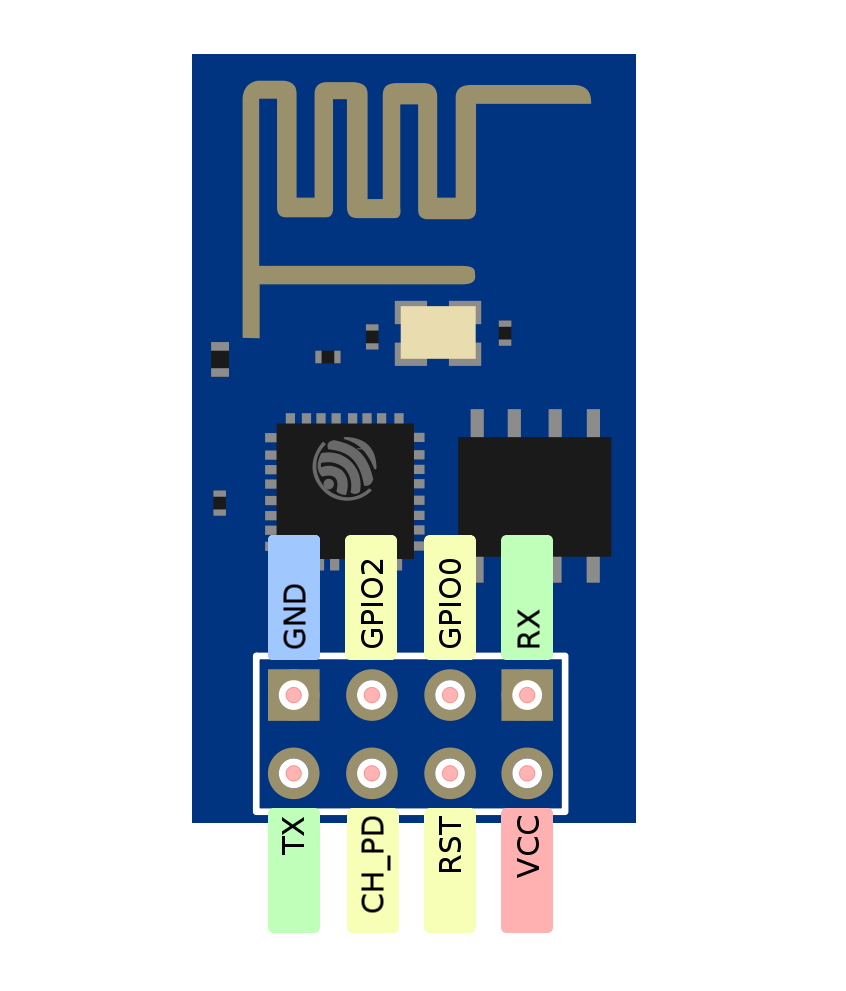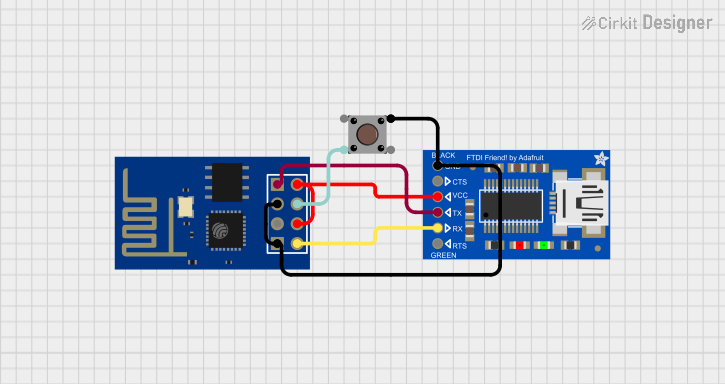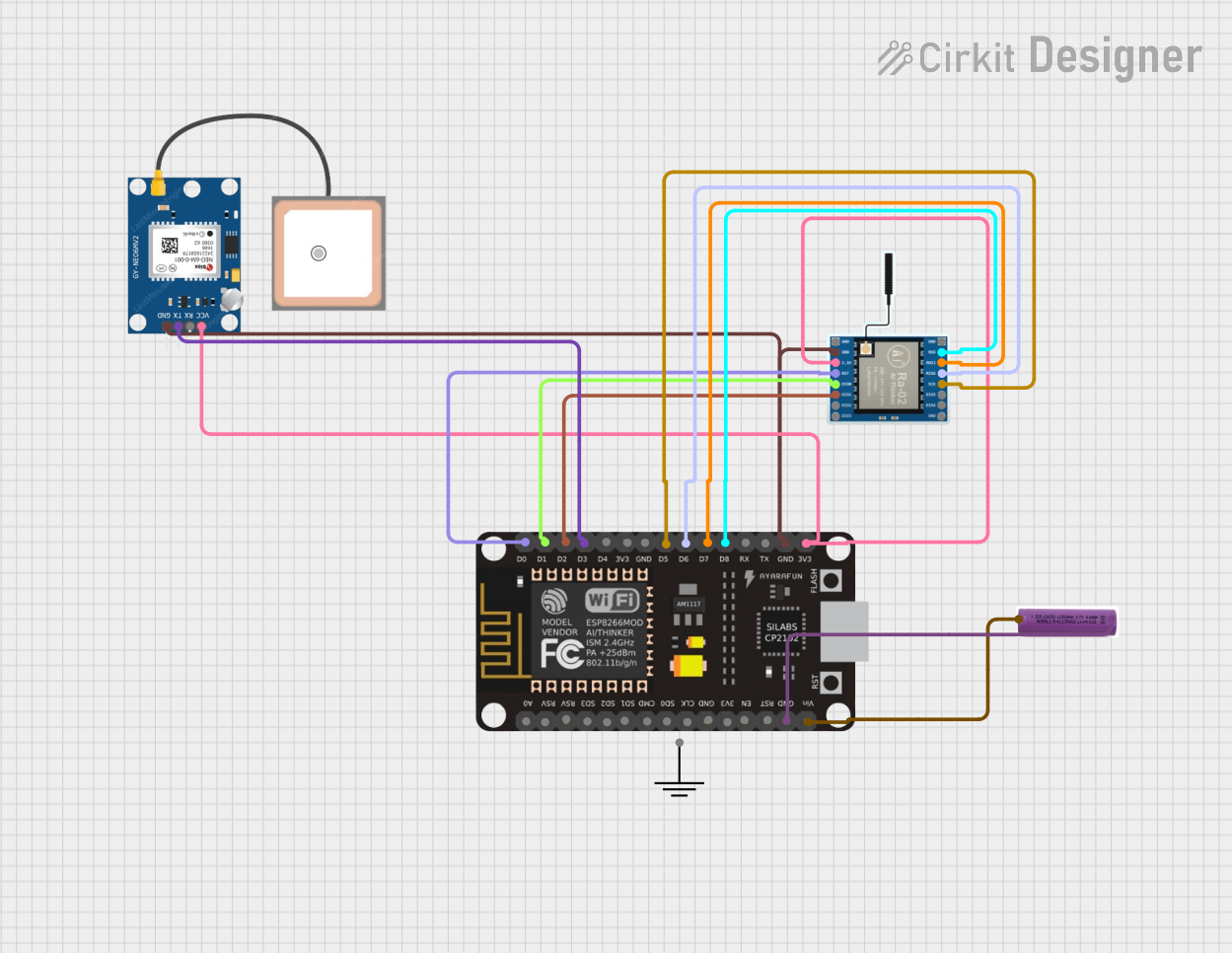
How to Use ESP-01 Module: Examples, Pinouts, and Specs

 Design with ESP-01 Module in Cirkit Designer
Design with ESP-01 Module in Cirkit DesignerIntroduction
The ESP-01 Module is a compact Wi-Fi microcontroller module based on the ESP8266 chip. It is widely used in Internet of Things (IoT) applications due to its built-in Wi-Fi capabilities, low cost, and ease of use. The module allows devices to connect to the internet or communicate with other devices wirelessly. It can be programmed using the Arduino IDE or other development environments, making it a versatile choice for hobbyists and professionals alike.
Explore Projects Built with ESP-01 Module

 Open Project in Cirkit Designer
Open Project in Cirkit Designer
 Open Project in Cirkit Designer
Open Project in Cirkit Designer
 Open Project in Cirkit Designer
Open Project in Cirkit Designer
 Open Project in Cirkit Designer
Open Project in Cirkit DesignerExplore Projects Built with ESP-01 Module

 Open Project in Cirkit Designer
Open Project in Cirkit Designer
 Open Project in Cirkit Designer
Open Project in Cirkit Designer
 Open Project in Cirkit Designer
Open Project in Cirkit Designer
 Open Project in Cirkit Designer
Open Project in Cirkit DesignerCommon Applications and Use Cases
- Home automation systems
- Wireless sensor networks
- Smart appliances
- Remote data logging
- IoT prototyping and development
- Wireless control of devices (e.g., relays, LEDs, motors)
Technical Specifications
Key Technical Details
- Chipset: ESP8266
- Operating Voltage: 3.0V to 3.6V (3.3V recommended)
- Current Consumption:
- Idle: ~70mA
- Peak (Wi-Fi transmission): ~200mA
- Wi-Fi Standards: 802.11 b/g/n
- Flash Memory: 1MB (8Mbit)
- GPIO Pins: 2 (GPIO0 and GPIO2)
- Communication Protocols: UART, SPI, I2C (limited support)
- Baud Rate: Default 115200 (configurable)
- Dimensions: 14.3mm x 24.8mm
Pin Configuration and Descriptions
The ESP-01 Module has 8 pins, as shown below:
| Pin Number | Pin Name | Description |
|---|---|---|
| 1 | GND | Ground (0V reference) |
| 2 | GPIO2 | General Purpose Input/Output Pin 2 |
| 3 | GPIO0 | General Purpose Input/Output Pin 0 (used for boot mode selection) |
| 4 | RX | UART Receive Pin (used for serial communication) |
| 5 | TX | UART Transmit Pin (used for serial communication) |
| 6 | CH_PD | Chip Enable (must be pulled HIGH for normal operation) |
| 7 | VCC | Power Supply (3.3V input) |
| 8 | RST | Reset Pin (active LOW, used to reset the module) |
Usage Instructions
How to Use the ESP-01 Module in a Circuit
- Power Supply: Ensure the module is powered with a stable 3.3V supply. Do not connect it directly to 5V as it may damage the module.
- Connections:
- Connect the GND pin to the ground of your circuit.
- Connect the VCC pin to a 3.3V power source.
- Pull the CH_PD pin HIGH (connect it to 3.3V) to enable the module.
- Use the RX and TX pins for serial communication with a microcontroller or USB-to-TTL adapter.
- Programming:
- To upload code, connect GPIO0 to GND to enter programming mode.
- After uploading, disconnect GPIO0 from GND and reset the module.
Important Considerations and Best Practices
- Use a voltage regulator or level shifter if interfacing with 5V logic devices.
- Add a 10µF capacitor between VCC and GND to stabilize the power supply.
- Avoid excessive current draw on GPIO pins (maximum 12mA per pin).
- Use a USB-to-TTL adapter with 3.3V logic levels for programming and communication.
Example: Connecting ESP-01 to Arduino UNO
Below is an example of using the ESP-01 Module with an Arduino UNO to connect to a Wi-Fi network and send data to a server.
Circuit Connections
- ESP-01 VCC → 3.3V (external power supply)
- ESP-01 GND → GND
- ESP-01 RX → Arduino Pin 2 (via voltage divider for 3.3V logic)
- ESP-01 TX → Arduino Pin 3
- ESP-01 CH_PD → 3.3V
- ESP-01 GPIO0 → Leave unconnected (HIGH by default)
Arduino Code
#include <SoftwareSerial.h>
// Define RX and TX pins for SoftwareSerial
SoftwareSerial espSerial(2, 3); // RX = Pin 2, TX = Pin 3
void setup() {
// Start serial communication with ESP-01
espSerial.begin(115200);
Serial.begin(9600); // For debugging via Serial Monitor
// Send AT command to test communication
Serial.println("Sending AT command...");
espSerial.println("AT");
}
void loop() {
// Check if ESP-01 has sent any data
if (espSerial.available()) {
String response = espSerial.readString();
Serial.println("ESP-01 Response: " + response);
}
// Check if user has sent data via Serial Monitor
if (Serial.available()) {
String command = Serial.readString();
espSerial.println(command); // Forward command to ESP-01
}
}
Notes
- Ensure the ESP-01 baud rate matches the
espSerial.begin()value. - Use a level shifter or voltage divider for the Arduino TX pin to avoid damaging the ESP-01.
Troubleshooting and FAQs
Common Issues and Solutions
ESP-01 Not Responding to AT Commands:
- Ensure the module is powered with a stable 3.3V supply.
- Verify the baud rate of the ESP-01 matches the serial communication settings.
- Check the connections, especially RX and TX pins.
Wi-Fi Connection Fails:
- Double-check the SSID and password in your code.
- Ensure the Wi-Fi network is within range and supports 2.4GHz (ESP-01 does not support 5GHz).
Module Overheating:
- Avoid powering the module directly from a 5V source.
- Use a proper heat sink or ensure adequate ventilation.
Upload Errors During Programming:
- Ensure GPIO0 is connected to GND during programming.
- Reset the module after uploading the code.
FAQs
Can the ESP-01 be used as a standalone microcontroller? Yes, the ESP-01 can be programmed using the Arduino IDE or other environments to function as a standalone microcontroller.
What is the maximum range of the ESP-01? The range depends on the environment but typically extends up to 100 meters in open spaces.
Can the ESP-01 operate on 5V? No, the ESP-01 operates on 3.3V. Using 5V can damage the module.
How do I restore the ESP-01 to factory settings? Send the
AT+RESTOREcommand via serial communication to reset the module to its default state.